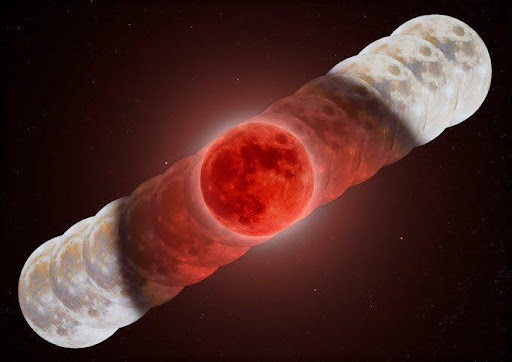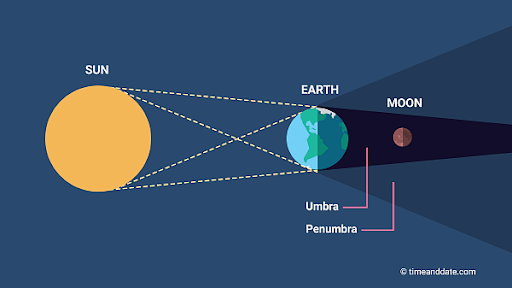Circle the date, folks! September 7–8, 2025, in your calendar because the night sky has a remarkable event planned. The bright Moon will gradually get duller and radiate a strange red when a total lunar eclipse takes place, and the best part is that without the use of telescopes, cameras, or filters, anyone in India can enjoy this captivating performance. Let’s dig in to find out more about this mesmerising event and to plan out our observations.
When to Watch in India
This eclipse will be entirely visible across India, making it one of the most awaited sky events of the year. Here’s the timeline (IST):
- Penumbral Eclipse begins: ~8:58 PM (P1)
- Partial Eclipse begins: ~9:58 PM (U1)
- Total Eclipse (Blood Moon) begins: ~11:00 PM (U2)
- Maximum Eclipse: ~11:41 PM
- Total Eclipse ends: ~12:22 AM (U3)
- Partial Eclipse ends: ~1:56 AM (U4)
- Penumbral Eclipse ends: ~2:25 AM (P4)
That means the prime time to watch the Blood Moon is between 11:00 PM and 12:22 AM – a full 82 minutes of lunar magic.

How to Observe the Eclipse
Unlike a solar eclipse, lunar eclipses are completely safe to view with the naked eye. No glasses, no filters—just your eyes and the Moon.
- Find an open space away from city lights.
- Use binoculars to see the Moon’s surface details during totality.
- If you have a telescope, it’s a treat—you’ll notice the Moon’s craters glowing faintly red.
- Carry a mat or chair, and make it a comfortable night under the stars.
Why Does the Moon Turn Red?
During a total lunar eclipse, the Earth passes between the Sun and the Moon. Instead of going entirely dark, the Moon glows red because the Earth’s atmosphere bends sunlight, scattering blue light while permitting red light to reach the Moon. This is why it is commonly referred to as a “Blood Moon.”
So, what you’re really seeing is all the world’s sunsets and sunrises reflected on the Moon at once. Beautiful, isn’t it?

Is every Red Moon an Eclipse?
A total lunar eclipse requires the Sun, Earth, and Moon to be exactly aligned with the Moon passing through the Earth’s umbra, and therefore, “red moon” is not always a lunar eclipse. The Moon’s orbit is tilted around 5 degrees relative to Earth’s orbit, causing it to travel above or below Earth’s shadow most months, preventing this exact alignment, which only occurs a few times a year.
Myths vs Science – Don’t Believe These!
Throughout history, lunar eclipses have been surrounded by myths and superstitions. Let’s clear the air today:
- Myth: Eclipses are inauspicious and harmful.
Truth: They are natural celestial events—absolutely harmless.
- Myth: Food spoils or should not be eaten during an eclipse.
Truth: There’s no scientific evidence—your dinner is safe!
- Myth: Pregnant women must avoid stepping outside.
Truth: Completely false. The eclipse has zero effect on human health.
Remember: A lunar eclipse is science in action, not superstition.
Now that we have cleared the air, here are some tips to capture the Eclipse:
Want to freeze this cosmic moment forever? Try these:
- Smartphone: Use a tripod, turn on night/pro mode, and reduce exposure.
- Camera: Use a telephoto lens (200mm+), settings around ISO 200–800, f/8–f/11, 1/60 sec.
- Binocular trick: Place your phone camera at the eyepiece—instant zoom shot!
- Telescope: Any telescope would do the trick for taking a zoomed-in photo.
Make It an Experience – Eclipse Watch Party Ideas
Why just watch when you can celebrate?
- Host a sky picnic with friends or family.
- Encourage kids to sketch the Moon phases as it changes.
- Set up a small telescope station for everyone to peek through.
- Add fun with a myth-busting quiz to make it both entertaining and educational.
Final Thought
On the night of September 7, don’t just glance at your phone for updates—step outside, look up, and soak in one of the rarest celestial spectacles. The Moon will remind us how small we are in the vast.
—
If you like the blog, enrol your school or yourself (K-12 student) in our School Programs or Online Programs, call us at +91-74020 74020 or write to us for any query: getintouch@space-india.com

